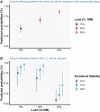One Velocity Loss Threshold Does Not Fit All: Consideration of Sex, Training Status, History, and Personality Traits When Monitoring and Controlling Fatigue During Resistance Training
- PMID: 37668949
- PMCID: PMC10480128
- DOI: 10.1186/s40798-023-00626-z
One Velocity Loss Threshold Does Not Fit All: Consideration of Sex, Training Status, History, and Personality Traits When Monitoring and Controlling Fatigue During Resistance Training
Abstract
Purpose: This study aimed to quantify the potential variability in the volume of work completed after reaching different velocity loss (VL) thresholds and determine the effects of sex, training status and history, as well as psychological traits on the reliability and magnitude of the amount of work completed after reaching different VL thresholds using different loads in the back-squat exercise.
Methods: Forty-six resistance-trained people (15 females and 31 males; 18 to 40 years of age) with a wide range of strength levels, training experience, and different training practices were recruited and performed a one-repetition maximum (1RM) test, and two repetitions to failure (RTF) tests 72 h apart. RTF tests were performed with 70, 80, and 90% of 1RM with 10 min of rest between sets. The Bland-Altman analysis for multiple observations per participant and equivalence tests were used to quantify the variability in the volume of work completed after reaching different VL thresholds, whereas linear and generalised mixed-effects models were used to examine the effects of different moderators on the stability and magnitude of the amount of work completed after reaching different VL thresholds.
Results: The findings of the present study question the utility of using VL thresholds to prescribe resistance training (RT) volume as the agreement in the amount of work completed across two consecutive testing sessions was not acceptable. Regardless of the load used, females completed more repetitions than males across VL thresholds, while males performed repetitions at higher velocities. In addition, individuals with higher levels of emotional stability also tended to perform more repetitions across VL thresholds. Finally, sex, choice of load, strength levels and training practices, as well as emotional stability affected the linearity of the repetition-velocity relationship and when sets terminated.
Conclusion: Using the same VL thresholds for all individuals, while assuming generalisability of the stimuli applied, would likely lead to variable acute physiological responses to RT and divergent neuromuscular adaptations over long term. Therefore, VL monitoring practices could be improved by considering sex, training status, history, and psychological traits of individuals due to their effects on the variability in responses to different VL thresholds.
Keywords: Exercise monitoring; Exercise prescription; Strength training; Velocity-based training.
© 2023. Springer Nature Switzerland AG.
Conflict of interest statement
Ivan Jukic, Katarina Prnjak, Michael McGuigan, and Eric Helms declare that they have no conflicts of interest relevant to the content of this manuscript.
Figures






References
LinkOut - more resources
Full Text Sources

